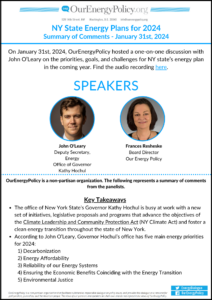The OurEnergyLibrary aggregates and indexes publicly available fact sheets, journal articles, reports, studies, and other publications on U.S. energy topics. It is updated every week to include the most recent energy resources from academia, government, industry, non-profits, think tanks, and trade associations. Suggest a resource by emailing us at info@ourenergypolicy.org.
Resource Library
Solar energy is abundant, affordable and a big part of America’s transition to renewable energy. Solar power is particularly valuable when it produces energy right where we need it: on the rooftops of our homes and businesses.
Rooftop solar is good for the environment and consumers – reducing our dependence on fossil fuels, easing strain on the grid during periods of high demand, increasing resilience to threats like extreme weather, and limiting the amount of land needed for clean energy, all at steadily falling cost.
State and local policies that make it easier for homeowners and business owners to install …
This report explores the incentives for BVCM over which the broader climate ecosystem has influence, including civil society, academia, policymakers, standard setters, advocacy organizations and multilateral organizations. It draws upon SBTi research to consider the barriers and incentives for private sector adoption of BVCM.
The report proposes a toolbox for accelerating corporate adoption and implementation of BVCM and sets out recommendations for different actors, offering a shared vision and “theory of change” for scaling corporate climate finance into BVCM over the coming decades.…
The “Above and Beyond” report provides suggestions to support companies in the design and implementation of BVCM strategies to accelerate progress towards global net-zero.
The report explores the business case for companies to adopt BVCM, and describes the suggested steps involved in making a BVCM pledge. It also provides illustrative examples to show how companies in a range of sectors might implement BVCM inline with the suggestions provided.…
The Inflation Reduction Act (IRA) is a monumental investment in the American energy economy that fundamentally changes utility integrated resource plans (IRPs).
Unfortunately, early indications show that most utilities are not fully considering the benefits of the IRA, leaving significant money on the table and increasing the risk of challenges down the line that we could be solving for now. Resource plans that do not incorporate IRA opportunities designed to reduce the cost of zero-emissions resources, prepare for the impacts of customer adoption of electrified technologies, or anticipate the incentives for large industrial loads, are not accurate — and are …
View Full ResourceThey assess which waters the Clean Water Act protects and how Supreme Court and White House rules change this regulation. They train a deep learning model using aerial imagery and geophysical data to predict 150,000 jurisdictional determinations from the Army Corps of Engineers, each deciding regulation for one water resource. Under a 2006 Supreme Court ruling, the Clean Water Act protects two-thirds of US streams and over half of wetlands; under a 2020 White House rule, it protects under half of streams and a fourth of wetlands, implying deregulation of 690,000 stream miles, 35 million wetland acres, and 30% of …
View Full ResourceWildfires ignited by power system infrastructure tend to cause more damage than other ignition sources because they occur during high wind events when fire spreads rapidly. Utilities are exploring a range of approaches to mitigate these wildfire risks. This study evaluates the cost, reliability, and wildfire risk implications of measures recently deployed by the largest utility in the United States – Pacific Gas and Electric.
Using detailed data on weather, vegetation, and infrastructure conditions from over twenty-five thousand miles of high-risk distribution lines, they use a prediction model trained on pre-intervention outcomes to estimate highly granular measures of baseline ignition …
On January 31st, 2024, OurEnergyPolicy hosted a one-on-one discussion with John O’Leary on the priorities, goals, and challenges for NY state’s energy plan in the coming year. Read this resource for a summary of this discussion!…
View Full ResourceDirect pay enables tax-exempt entities to receive payment equal to the full value of the Investment Tax Credit (ITC) and its bonus credits after a clean energy project has been placed in service. This new provision from the Inflation Reduction Act will allow nonprofit organizations, states, local governments, and Tribal Nations, among others to more fully participate in the benefits of clean energy.
This document seeks to provide a roadmap of the key steps to receive direct pay reimbursement for the ITC and an easy way to track progress through those steps to ensure no deadlines are missed. Projects can …
Direct pay enables tax-exempt entities to receive payment equal to the full value of the Investment Tax Credit (ITC) and its bonus credits. Nonprofits, states, local governments, and Tribal Nations are all able to more fully participate in the benefits of clean energy through Direct Pay.
This Direct Pay Fact Sheet details which types of tax-exempt entities are eligible to receive direct pay, outlines the process to receive direct pay, and introduces additional resources. …
The recently enacted Bipartisan Infrastructure Law (BIL) and Inflation Reduction Act (IRA) together represent historic investments in the future of our nation that will transform how we move and live while we build the backbone of a safer and more sustainable transportation system.
This Blueprint for Transportation Decarbonization follows the momentum from those investments to crystallize a first-of-its-kind strategy for federal leadership and partnerships to decarbonize the entire U.S. transportation sector.
Decarbonizing transportation will affect everyone, and solutions must address the needs of all urban, suburban, and rural communities; businesses of all sizes; and individuals and families at every socioeconomic …









